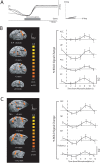Connectivity of the primate superior colliculus mapped by concurrent microstimulation and event-related FMRI
- PMID: 19079541
- PMCID: PMC2592545
- DOI: 10.1371/journal.pone.0003928
Connectivity of the primate superior colliculus mapped by concurrent microstimulation and event-related FMRI
Abstract
Background: Neuroanatomical studies investigating the connectivity of brain areas have heretofore employed procedures in which chemical or viral tracers are injected into an area of interest, and connected areas are subsequently identified using histological techniques. Such experiments require the sacrifice of the animals and do not allow for subsequent electrophysiological studies in the same subjects, rendering a direct investigation of the functional properties of anatomically identified areas impossible.
Methodology/principal findings: Here, we used a combination of microstimulation and fMRI in an anesthetized monkey preparation to study the connectivity of the superior colliculus (SC). Microstimulation of the SC resulted in changes in the blood oxygenation level-dependent (BOLD) signals in the SC and in several cortical and subcortical areas consistent with the known connectivity of the SC in primates.
Conclusions/significance: These findings demonstrates that the concurrent use of microstimulation and fMRI can be used to identify brain networks for further electrophysiological or fMRI investigation.
Conflict of interest statement
Figures








Similar articles
-
Translation of sensory signals into commands for control of saccadic eye movements: role of primate superior colliculus.Physiol Rev. 1986 Jan;66(1):118-71. doi: 10.1152/physrev.1986.66.1.118. Physiol Rev. 1986. PMID: 3511480 Review.
-
Mapping cortical activity elicited with electrical microstimulation using FMRI in the macaque.Neuron. 2005 Dec 22;48(6):901-11. doi: 10.1016/j.neuron.2005.11.034. Neuron. 2005. PMID: 16364895
-
Polar-angle representation of saccadic eye movements in human superior colliculus.Neuroimage. 2018 May 1;171:199-208. doi: 10.1016/j.neuroimage.2017.12.080. Epub 2017 Dec 30. Neuroimage. 2018. PMID: 29292132 Free PMC article.
-
Mapping functional gradients of the striatal circuit using simultaneous microelectric stimulation and ultrahigh-field fMRI in non-human primates.Neuroimage. 2021 Aug 1;236:118077. doi: 10.1016/j.neuroimage.2021.118077. Epub 2021 Apr 18. Neuroimage. 2021. PMID: 33878384
-
MR imaging in the non-human primate: studies of function and of dynamic connectivity.Curr Opin Neurobiol. 2003 Oct;13(5):630-42. doi: 10.1016/j.conb.2003.09.017. Curr Opin Neurobiol. 2003. PMID: 14630229 Review.
Cited by
-
Dissecting the Prefrontal Network With Pathway-Selective Manipulation in the Macaque Brain-A Review.Front Neurosci. 2022 May 23;16:917407. doi: 10.3389/fnins.2022.917407. eCollection 2022. Front Neurosci. 2022. PMID: 35677354 Free PMC article. Review.
-
Delayed Onset of Inhibition of Return in Visual Snow Syndrome.Front Neurol. 2021 Sep 17;12:738599. doi: 10.3389/fneur.2021.738599. eCollection 2021. Front Neurol. 2021. PMID: 34603190 Free PMC article.
-
Activation of Direct and Indirect Pathway Medium Spiny Neurons Drives Distinct Brain-wide Responses.Neuron. 2016 Jul 20;91(2):412-24. doi: 10.1016/j.neuron.2016.06.010. Epub 2016 Jun 30. Neuron. 2016. PMID: 27373834 Free PMC article.
-
High-field FMRI reveals brain activation patterns underlying saccade execution in the human superior colliculus.PLoS One. 2010 Jan 13;5(1):e8691. doi: 10.1371/journal.pone.0008691. PLoS One. 2010. PMID: 20084170 Free PMC article.
-
FMRI activity in the macaque cerebellum evoked by intracortical microstimulation of the primary somatosensory cortex: evidence for polysynaptic propagation.PLoS One. 2012;7(10):e47515. doi: 10.1371/journal.pone.0047515. Epub 2012 Oct 31. PLoS One. 2012. PMID: 23118875 Free PMC article.
References
-
- Ungerleider LG, Desimone R. Cortical connections of visual area MT in the macaque. JComp Neurol. 1986;248:190. - PubMed
-
- Leichnetz GR, Spencer RF, Hardy SG, Astruc J. The prefrontal corticotectal projection in the monkey; an anterograde and retrograde horseradish peroxidase study. Neuroscience. 1981;6:1023. - PubMed
-
- Felleman DJ, Van Essen DC. Distributed hierarchical processing in the primate cerebral cortex. CerebCortex. 1991;1:1. - PubMed
-
- Boldogkoi Z, Sik A, Denes A, Reichart A, Toldi J, et al. Novel tracing paradigms–genetically engineered herpesviruses as tools for mapping functional circuits within the CNS: present status and future prospects. Prog Neurobiol. 2004;72:417–445. - PubMed
-
- Kobbert C, Apps R, Bechmann I, Lanciego JL, Mey J, et al. Current concepts in neuroanatomical tracing. Prog Neurobiol. 2000;62:327–351. - PubMed
Publication types
MeSH terms
Substances
LinkOut - more resources
Full Text Sources
Medical

